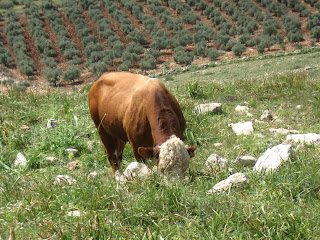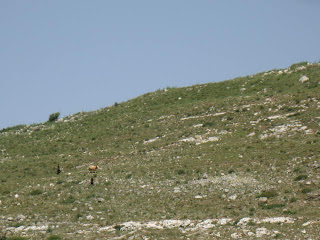Tuesday, April 6, 2010
My so-called proficiency
"Except ye...become as little children, ye shall not enter into the kingdom of heaven.." One might rephrase this: except ye become as a little child, ye shall not be able to speak Koine Greek." When I came here a week ago, I can quite accurately say that I could not speak a coherent sentence in Greek, Koine or otherwise. I had a fairly large recognition vocabulary, good analytical skills, and could puzzle my way through most any text with the help of a dictionary. I could parse verbs with the best of them. But I could not speak, nor would I call what I was doing with those texts as "reading." No, I was translating.
To be fair to my professors, speaking Greek (or for that matter, Latin) was never a goal of my classical education. I simply was not taught that way. It may have been the case that young English schoolboys of the previous century, starting Latin and Greek at the tender age of six or seven, may have had the ability to do so. No, the basic philosophy was (and is) that ancient Greek and Latin are "dead" languages, killed by (among others) Dante and Chaucer and Erasmus and Luther, who spearheaded the move from these languages to the vernacular. And thank heavens for that, to, or we would never be able to read the Bible in our own language if it weren't for their efforts.
But there is a wave of change spreading through the world of Ancient language acquisition. Led by scholars such as Randall Buth and "Terentius" Tunberg, there has been an effort to teach people how to speak and read Biblical Hebrew, Koine Greek, and Latin as if they were still living languages…
Skeptics will immediately say that not only is this pointless (they are NOT "living" languages) but that it is also virtually impossible to do so based on some pretty big roadblocks on the road to fluency. For one, pronunciation. This is not the place to tackle this controversy in detail, but suffice it to say that Buth and others claim that the so-called "Erasmian" pronunciation usually taught in Classical and Koine Greek courses is in a word, utterly inaccurate (o.k., that's two words, but you get the point) For more on the controversy, see:
So back to my first day. I can't speak, I don't understand the pronunciation, so even the words that I do know, I cannot recognize. The Greeks had a word for my condition: aporia. ("The state of utterly lacking resources" approximates a translation.)
Resist? Scoff? ("It's a pretty parlor trick, but a waste of time") Or humble myself? I chose the latter. And now, a week later, I can speak some Greek. Haltingly, stumbling over verb forms, but gamely trying to press on. There are times when I find myself utterly frustrated at my inadequacy, and it's tough to be constantly corrected on my pronunciation. To be honest, I am often filled with irritation and my inner monologue is more Anglo-Saxon than Koine Greek.
And yet, I can understand the usefulness of this process. To have noun and verb forms inside me, to know well enough to produce them instantly, would allow me to do what, after all, I wanted to do from the very start: to read Greek quickly, with comprehension, and, (wonder of wonders) with enjoyment.
And so, as a little child, I press on...
Thursday, April 1, 2010
The Journey begins...
If you go to Israel, having someone who knows Israel like the proverbial back of his hand is a real asset! As we left Tel Aviv in our rented car, Brian was able to show me everything from the new railroad line, to the characteristic white building stone with which virtually all buildings are constructed, to the bombed-out shells of armored cars used to move supplies into the beleaguered city during the blockade of Jerusalem in the 1948 War.
We drove from Tel Aviv to Jerusalem (gaining some 800 meters in elevation!) and were able to see much of the city. The parks were crammed full of families on holiday, barbecuing and
 enjoying the great weather.
enjoying the great weather.
The traffic was, how shall we say, entertaining and terrifying. Luckily Brian could drive with the best (or worst?) of them. After a short stop in Jerusalem, we started the drive to the Sea of Galilee. As we left the city, I was able to catch a brief glimpse of the Dome of the Rock. It's always truly amazing to see a site that you've previously only seen in photographs. (It was so brief I could not capture it on film)
We passed several Palestinian settlements and the huts of the Bedouins whose water tanks are
the only supply of water in what appears to be an uncompromising landscape, but which Brian informs me are actually the "green pastures" of Psalm 23!

In fact, we saw several shepherds with their flocks of sheep or goats, and their lifestyle cannot have changed very much since the time of David.
 These people eke out a very bare existence. Just looking at the hot sheets of metal covering the makeshift shelters made me thirsty.
These people eke out a very bare existence. Just looking at the hot sheets of metal covering the makeshift shelters made me thirsty.After a while we began the long descent into the valley of the Dead Sea, passing numerous hitchhikers of both sexes along the way. (To hitch a ride in Israel, you don't stick out your thumb, but point your index finger toward the road.) Brian says that hitchhiking in Israel is safe and ubiquitous.
 The Dead Sea
The Dead SeaDown, down, down we went, to the lowest point on earth. Brian's water bottle shriveled to half its size from the loss of pressure and our ears popped.

The landscape around the lake was moon-like in its barrenness, but once we passed the lake we came across several Palestinian tourist stops, with everything from sheepskins to junk food to pots to camel rides.

This mournful camel knelt on the hot pavement and no doubt dreamed of retirement--or at least taking a healthy bite out of its human burden!
Shortly after the Dead Sea we turned north and followed Route 90 to the Galilee. Traffic diminished rapidly as we turned west towards Tiberias. This area is heavily Palestinian. It was dark when we reached Tiberias (we were stopped at a security check point and had to bring all our bags out of the car, where they were x-rayed and our car meticulously searched.) Brian said that if I hadn't spoken to them in English, they probably would not have stopped us. Now I know.... They seemed especially preoccupied with Brian's back-up hard drive. Soon, however, were back on the road.
Tiberias is a popular tourist town on the shores of the Galilee, and it was jam-packed with people enjoying the Passover holiday. Traffic was inching along for most of the town, and I was able to people-watch. Just past the town, one campground after another was crammed full of small dome tents, hundreds, pitched right on top on one another...just one great big party.
We turned off the main road at Migdal (Ancient Magdala, the home town of Mary Magdalene) and drove up the hill a ways to our guest house, Beit Bracha ("House of Blessing").
 Brian at Beit Bracha
Brian at Beit Bracha
Tuesday, March 30, 2010
Day Two: Field trip to Cana
Anyway.
To get to the site of Cana, we drove into an area almost entirely settled by Palestinians, where each small village had its own mosque with a minaret and a green dome, and all the signs were in Arabic.
As we passed in our four-car caravan, pedestrians gave us curious glances. We left the main road and proceeded to follow a rocky path which hardly deserved the appellation of "road." Thistles rose on either side of us, some over seven feet tall, with nasty pointy spikes.
We passed the fields of Palestinian farmers tucked away in the valley. The further we strayed from the main road, the more I thought about how we might be viewed by those who owned these fields. It was sort of a disquieting feeling.
Finally we reached the spot where we parked the cars. After a lunch that included matzo, hummus, olives, kohlrabi, we girded our loins (read: put on sunblock, hat with attached sunshade, and long-sleeved shirt) and set off.
The path soon ended and we began hiking straight up the hill. It was hot and rocky and soon I abandoned the straight-up approach for a modified switchback, following the cow paths. We arrived at the top hot, sweaty and a bit red-faced.
The modest ruins at the top would scarcely belie the biblical significance of the site.

I poured a libation (I am sorry to report that my water remained in its aqueous state.) A curious cow and her offspring wandered by.
Going up was hard, but going back down was even harder, as the loose rocks could be very treacherous.
But we made it safely back down.












